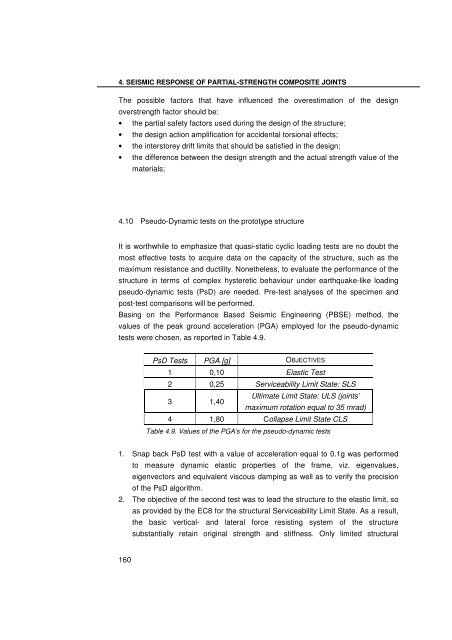Analysis and modelling of the seismic behaviour of high ... - Ingegneria
Analysis and modelling of the seismic behaviour of high ... - Ingegneria
Analysis and modelling of the seismic behaviour of high ... - Ingegneria
You also want an ePaper? Increase the reach of your titles
YUMPU automatically turns print PDFs into web optimized ePapers that Google loves.
4. SEISMIC RESPONSE OF PARTIAL-STRENGTH COMPOSITE JOINTS<br />
The possible factors that have influenced <strong>the</strong> overestimation <strong>of</strong> <strong>the</strong> design<br />
overstrength factor should be:<br />
• <strong>the</strong> partial safety factors used during <strong>the</strong> design <strong>of</strong> <strong>the</strong> structure;<br />
• <strong>the</strong> design action amplification for accidental torsional effects;<br />
• <strong>the</strong> interstorey drift limits that should be satisfied in <strong>the</strong> design;<br />
• <strong>the</strong> difference between <strong>the</strong> design strength <strong>and</strong> <strong>the</strong> actual strength value <strong>of</strong> <strong>the</strong><br />
160<br />
materials;<br />
4.10 Pseudo-Dynamic tests on <strong>the</strong> prototype structure<br />
It is worthwhile to emphasize that quasi-static cyclic loading tests are no doubt <strong>the</strong><br />
most effective tests to acquire data on <strong>the</strong> capacity <strong>of</strong> <strong>the</strong> structure, such as <strong>the</strong><br />
maximum resistance <strong>and</strong> ductility. None<strong>the</strong>less, to evaluate <strong>the</strong> performance <strong>of</strong> <strong>the</strong><br />
structure in terms <strong>of</strong> complex hysteretic <strong>behaviour</strong> under earthquake-like loading<br />
pseudo-dynamic tests (PsD) are needed. Pre-test analyses <strong>of</strong> <strong>the</strong> specimen <strong>and</strong><br />
post-test comparisons will be performed.<br />
Basing on <strong>the</strong> Performance Based Seismic Engineering (PBSE) method, <strong>the</strong><br />
values <strong>of</strong> <strong>the</strong> peak ground acceleration (PGA) employed for <strong>the</strong> pseudo-dynamic<br />
tests were chosen, as reported in Table 4.9.<br />
PsD Tests PGA [g] OBJECTIVES<br />
1 0,10 Elastic Test<br />
2 0,25 Serviceability Limit State: SLS<br />
3 1,40<br />
Ultimate Limit State: ULS (joints’<br />
maximum rotation equal to 35 mrad)<br />
4 1,80 Collapse Limit State CLS<br />
Table 4.9. Values <strong>of</strong> <strong>the</strong> PGA’s for <strong>the</strong> pseudo-dynamic tests<br />
1. Snap back PsD test with a value <strong>of</strong> acceleration equal to 0.1g was performed<br />
to measure dynamic elastic properties <strong>of</strong> <strong>the</strong> frame, viz. eigenvalues,<br />
eigenvectors <strong>and</strong> equivalent viscous damping as well as to verify <strong>the</strong> precision<br />
<strong>of</strong> <strong>the</strong> PsD algorithm.<br />
2. The objective <strong>of</strong> <strong>the</strong> second test was to lead <strong>the</strong> structure to <strong>the</strong> elastic limit, so<br />
as provided by <strong>the</strong> EC8 for <strong>the</strong> structural Serviceability Limit State. As a result,<br />
<strong>the</strong> basic vertical- <strong>and</strong> lateral force resisting system <strong>of</strong> <strong>the</strong> structure<br />
substantially retain original strength <strong>and</strong> stiffness. Only limited structural
















